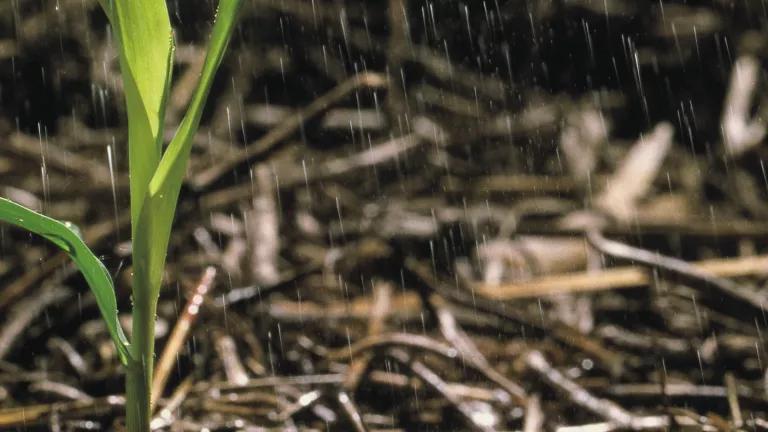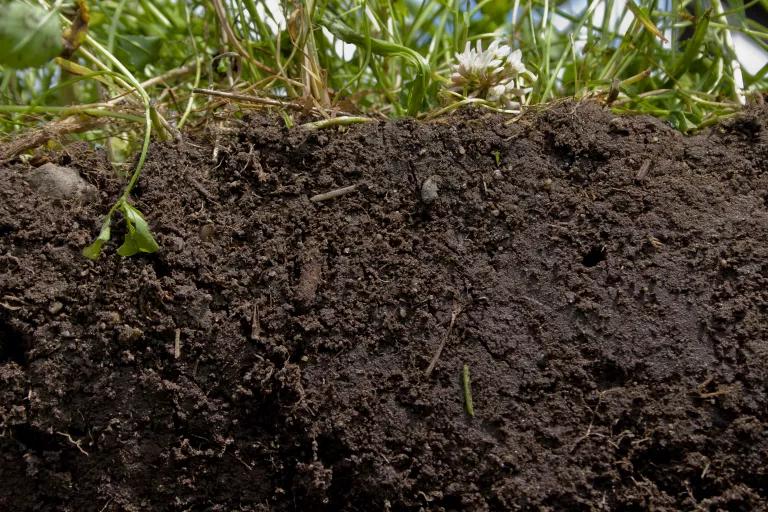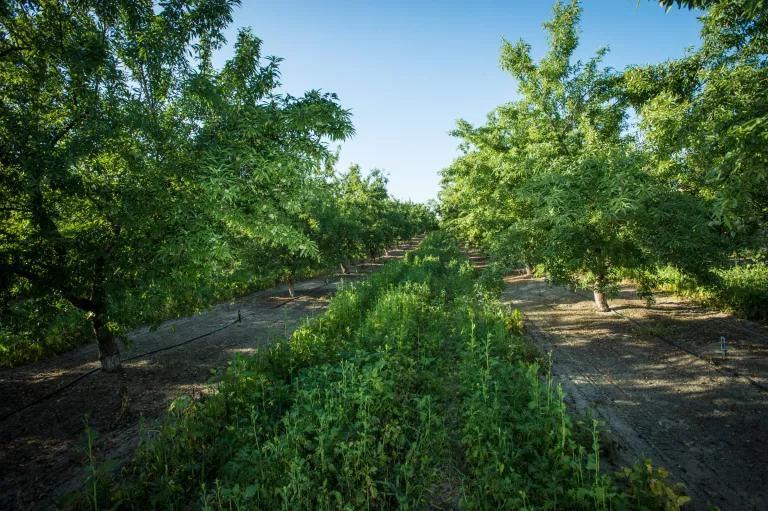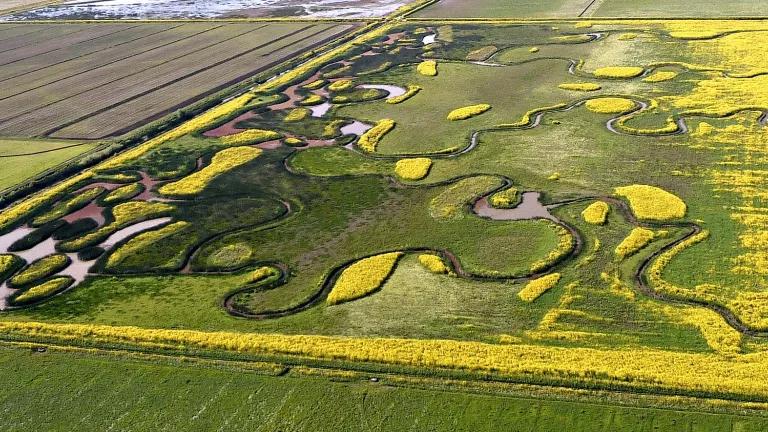How Regenerative Agriculture Can Mitigate Drought
This is how we can help California farms and ranches be part of a drought mitigation strategy.

Water falling on no-tilled field
For World Water Day, I’m thinking about my favorite topic, soil. Specifically, I’m thinking about California agriculture—a sector that uses approximately 80% of the state’s publicly developed water supply. Regenerative agriculture, which involves building soil health—nature’s reservoir—and using practices that reduce irrigation demands, can help California farms and ranches be part of a drought mitigation strategy.
Regenerative agriculture is a decision-making framework that farmers and ranchers use to grow in harmony with nature. The principles of regenerative agriculture can help California growers be more resilient to climate change and droughts. How? One of the core principles is building soil health.
Building Healthy Soil
Healthy soil acts like a sponge: When rain falls on a field with healthy soil, water can infiltrate instead of puddling and running off, which is what happens on fields with compacted, unhealthy soil. A 1% increase in soil organic matter (an indicator of soil health) increases water storage potential on an acre by more than 20,000 gallons.
Importantly, by increasing the water infiltration and storage capacities of soil, healthy soil can reduce the need for irrigation, which is how regenerative growers can reduce their demand for water and become more water independent.
Instead of relying on surface water deliveries, which are increasingly unpredictable, regenerative growers build their soil health and the natural water storage potential of their soils. California’s 4th Climate Change Assessment found that a 1% increase in soil organic matter on the state’s 26 million acres of crop and rangelands can potentially reduce irrigation demand by more than 208,000 acre feet. With a more ambitious but technically feasible 3% increase, the assessment estimates a potential reduction in irrigation demand of around 584,000 acre-feet per year.

Cross Section of Healthy Soil in Field of Cover Crops
Reducing Irrigation Demand
Reductions in irrigation demand are important. The Department of Water Resources (DWR) warns that by 2050, every year has a 50% chance of being in an extreme drought year like what we experienced in 2014.
Constructing new dams and reservoirs won’t make more rain fall from the sky. But reducing irrigation demand is a good way to prepare for a future with less water.
Reducing irrigation demand fits nicely with another principle of regenerative agriculture—understanding one’s natural resource constraints.

Close up of a black soaker hose dripping water onto the base of a plant as part of a drip irrigation system.
Regenerative growers can reduce their irrigation demand in a couple of ways:
- Upgrade to Water Efficient Irrigation Systems: Farmers can upgrade on-farm irrigation systems to be more water efficient (i.e. upgrading to drip or micro irrigation systems), which can help reduce agricultural water use by 5-6 million acre feet of water per year. California’s Statewide Water Efficiency and Enhancement Program (SWEEP) provides funding to upgrade irrigation systems, and according to the California Department of Food and Agriculture (CDFA) which oversees the program, SWEEP projects annually save 117,000 acre feet of water to date. We can do better. We must scale up irrigation upgrades and curtail any “rebound effects”--which is what happens when the water saved from irrigation upgrades goes to support expanding crop acreage.
- Grow Crops That Require Less Water: Farmers can grow crops that are not water intensive. Unfortunately, the growing trend of planting more water thirsty nut orchards like almonds, walnuts, and pistachios, doesn’t bode well for reducing California’s agricultural irrigation demands. In 2015, DWR estimated that more than 6.7 million acre feet (MAF) of water was applied on farms to grow almonds and pistachios–that’s more water used for two crops than was used by ALL California residents that year. DWR hasn’t updated its water application data for more recent crop years, but my guess is that water use for those crops increased given our state’s exploding nut orchard acreage.
Plant More Cover Crops
Pairing reductions in irrigation demand with farming practices that build soil health will get us some of the best results. Cover cropping is one of many regenerative practices that build soil health. Cover cropping is the practice of growing plants that cover soil in order to reduce soil erosion, increase water retention, improve soil health, increase biodiversity and more. Cover crops can be planted around the time of harvesting cash crops or in between rows of permanent crops. New research in California shows how farmers can plant winter cover crops without any significant difference in the total amount of water used on their farm. Unfortunately, less than 4% of California’s cropland uses cover crops, but grants provided by the Healthy Soils Program can help increase that percentage.

Cover crops in an almond orchard at Mota Ranch in Livingston, California
Here are three ways California can transition to regenerative agriculture, build soil health, and reduce overall irrigation demands:
Set a Target to Transition California’s Agriculture
California leaders must set a target to transition California agriculture to regenerative systems, including organic agriculture. Decision makers can coordinate existing administrative actions, opportunities, and budgets (i.e. the 2022 CARB Scoping Plan Update, California Water Portfolio update, Climate Smart Strategy, 30x30, FY 22 Budget) to plan for and fund transitions toward regenerative farming and ranching systems. Furthermore, the state must prioritize funding planning and funding for support for small, mid-scale, and socially disadvantaged farmers and ranchers. Even though small and mid-sized farmers (those growing on fewer than 1,000 acres) constitute 93.7% of total farms in the state, 76% of California farmland is managed on large farms that are 1,000 or more acres. Farms that are 1,000 acres and larger also account for 62 percent of total irrigated acres, so targeting support for small and mid-size farms is essential to help with transitioning. Many Hmong and Mien growers in the Central Valley, for example, grow more than 100 varieties of specialty produce on farms that are 2-15 acres. These regenerative operations are pillars of food security in their communities and should be emulated state-wide.
Increase Funding and Reform Programs
State leaders must pair increases in funding to the California’s Healthy Soils Program (HSP) with necessary reforms to the program to increase access for small, more diversified growers. The HSP provides grants to offset the costs of using farming practices that build soil health. Year after year, demand for the program has skyrocketed, but limits placed by the program’s administrative costs and paperwork requirements mean larger scale operations benefit first. Furthermore, the program’s structure makes it difficult for farmers who frequently rotate crops–a common regenerative practice—to access funds. CDFA should make it easier for farmers who rotate multiple crops to access funds and prioritize HSP funds to support small, socially disadvantaged farmers and ranchers, not industrial systems.
Establish Rules That Prevent the Expansion of Crop Acreage
Policy makers must pair increased investments for SWEEP with rules that prohibit expanding crop acreage in the long-term. The rebound effect is problematic and prevents California from reducing overall irrigation demand. The Legislature should direct CDFA to investigate rebound effects from SWEEP, an idea supported by the Legislative Analyst’s Office, and prevent expansion of crop acreage from water saved.
What’s Next?
California’s facing another dry year and I’m as frustrated as the next advocate about the fact that we’re hearing the same talking points: “We need to plan better for next time,” “current water decisions are unsustainable,” “we all need to do our part to conserve.” We’re in more trouble now because groundwater supplies are at critical levels due to agriculture’s severe groundwater pumping, and even though laws were passed in 2014 to curtail groundwater pumping, communities are still seeing their drinking water wells dry up. Agriculture needs to be part of the state’s drought mitigation strategy. Regenerative agriculture gives us a framework to get it done.


